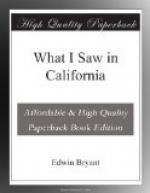While the men are employed in attending to the herds of cattle and horses, and engaged in their other amusements, the women (I speak of the middle classes on the ranchos) superintend and perform most of the drudgery appertaining to housekeeping, and the cultivation of the gardens, from whence are drawn such vegetables as are consumed at the table. These are few, consisting of frijoles, potatoes, onions, and chiles. The assistants in these labours are the Indian men and women, legally reduced to servitude.
The soil of that portion of California between the Sierra Nevada and the Pacific will compare, in point of fertility, with any that I have seen elsewhere. As I have already described such portions of it as have come under my observation, it is unnecessary for me here to descend to particulars. Wheat, barley, and other small grains, with hemp, flax, and tobacco, can be produced in all the valleys, without irrigation. To produce maize, potatoes, and other garden vegetables, irrigation is necessary. Oats and mustard grow spontaneously, with such rankness as to be considered nuisances upon the soil. I have forced my way through thousands of acres of these, higher than my head when mounted on a horse. The oats grow to the summits of the hills, but they are not here so tall and rank as in the valleys.
The varieties of grasses are greater than on the Atlantic side of the continent, and far more nutritious. I have seen seven different kinds of clover, several of them in a dry state, depositing a seed upon the ground so abundant as to cover it, which is lapped up by the cattle and horses and other animals, as corn or oats, when threshed, would be with us. All the grasses, and they cover the entire country, are heavily seeded, and, when ripe, are as fattening to stock as the grains which we feed to our beef, horses, and hogs. Hence it is unnecessary to the sustenance or fattening of stock to raise corn for their consumption.
Agriculture is in its rudest state. The farming implements which have been used by the Californians, with few exceptions, are the same as were used three hundred years ago, when Mexico was conquered by Cortez. A description of them would be tedious. The plough, however, which merely scratches the ground, is the fork of a small tree. It is the same pattern as the Roman plough, two thousand years ago. Other agricultural implements are of the same description. The Americans, and other foreigners, are, however, introducing the American plough, and other American farming tools, the consequence of which has already been, to some extent, to produce a revolution in agriculture. The crops of wheat and barley, which I saw about the 1st of June, while passing through the country on my journey to the United States, exceeded in promise any which I have seen in the United States. It was reported to me that Captain Sutter’s crop of wheat, for 1847, would amount to 75,000 bushels.




